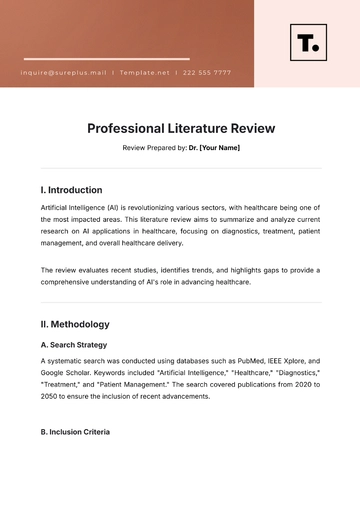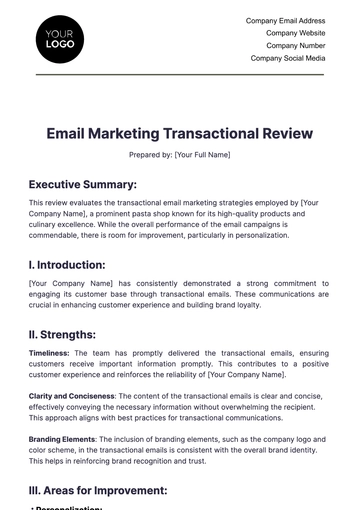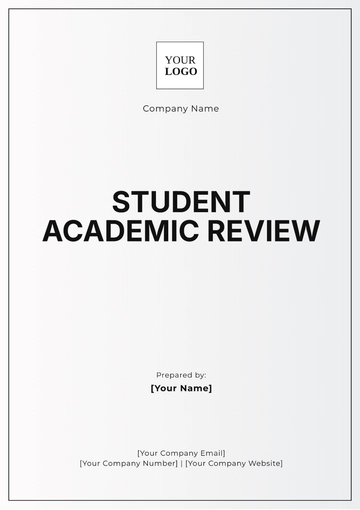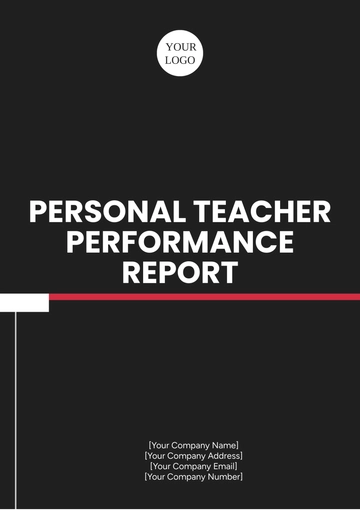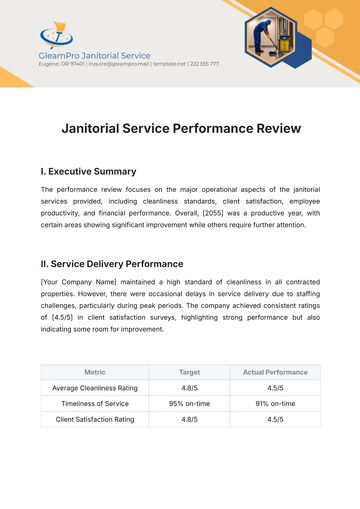Annual Business Review
[Your Company Name]
Annual Business Review
Date: January 1, 2055
Prepared By: [Your Name]
Email: [Your Email]
Company Contact Number: [Your Company Number]
1. Executive Summary
This annual business review provides a comprehensive evaluation of [Your Company Name]'s performance over the fiscal year 2054. It includes an analysis of financial results, market position, operational efficiency, and strategic goals. The review aims to identify strengths, weaknesses, opportunities, and threats to inform decision-making and drive continuous improvement.
Key Achievements:
Launched three new innovative products.
Expanded market presence in Asia and Europe.
Achieved a 15% increase in annual revenue.
Enhanced customer satisfaction ratings by 10%.
Challenges Faced:
Supply chain disruptions due to global events.
Increased competition in the tech industry.
Cybersecurity threats and data breaches.
Recommendations:
Invest in supply chain resilience.
Enhance cybersecurity measures.
Focus on innovation to stay ahead of competitors.
2. Financial Analysis
Financial Performance Summary
Metric | 2053 | 2054 | % Change |
|---|
Total Revenue | $50,000,000 | $57,500,000 | +15% |
Net Profit | $5,000,000 | $6,500,000 | +30% |
Gross Margin | 40% | 42% | +2% |
Operating Expenses | $20,000,000 | $22,000,000 | +10% |
Earnings Per Share (EPS) | $2.00 | $2.60 | +30% |
Income Statement:
Revenue growth driven by new product launches and market expansion. Increased operating expenses due to investments in R&D and marketing.
Balance Sheet:
Strengthened financial position with increased assets and equity. Improved liquidity ratios.
Cash Flow Statement:
Strong cash flow from operations, enabling significant reinvestment in the business.
3. Market Analysis
Market Overview:
The technology sector experienced robust growth in 2054, with increased demand for innovative solutions in AI and IoT.
Competitive Landscape:
[Your Company Name] maintains a strong competitive position but faces growing competition from emerging tech startups.
Customer Analysis:
Demographics: Primarily tech-savvy professionals aged 25-45.
Preferences: High demand for innovative and user-friendly products.
Behavior: Increased online purchasing and preference for sustainable products.
SWOT Analysis:
Strengths | Weaknesses |
|---|
Strong R&D capabilities | Dependence on a few key markets |
High customer satisfaction | Vulnerability to supply chain issues |
Robust financial performance | High operating costs |
Opportunities | Threats |
|---|
Expansion into new markets | Intense competition |
Development of new technologies | Cybersecurity risks |
Strategic partnerships | Regulatory changes |
4. Operational Review
Process Efficiency:
Implemented lean manufacturing techniques, resulting in a 5% reduction in production time.
Productivity:
Enhanced employee productivity through training programs and technology upgrades.
Technology and Innovation:
Invested in AI and machine learning to improve product development and customer service.
5. Strategic Review
Strategic Goals:
Increase market share by 10% in the next two years.
Develop five new innovative products by 2057.
Achieve carbon neutrality by 2060.
Progress and Achievements:
Met 2054 revenue targets.
Launched three new products ahead of schedule.
Reduced carbon footprint by 15%.
Future Direction:
Focus on expanding in emerging markets.
Invest in green technologies.
Strengthen digital transformation initiatives.
6. Performance Metrics
KPI | Target | Actual | Status |
|---|
Revenue Growth | 12% | 15% | Achieved |
Net Profit Margin | 10% | 11.3% | Achieved |
Customer Satisfaction Score | 85% | 90% | Achieved |
New Product Development | 3 products/year | 3 products/year | Achieved |
Employee Retention Rate | 90% | 88% | Not Achieved |
7. Customer Feedback
Customer Satisfaction:
Customer Complaints and Resolutions:
8. Risk Assessment
Risk Identification:
Risk Mitigation:
Diversify suppliers and build inventory buffers.
Implement advanced cybersecurity measures.
Regular compliance audits and training.
9. Recommendations
Short-term Recommendations:
Enhance supply chain resilience.
Increase marketing efforts in new regions.
Strengthen cybersecurity infrastructure.
Long-term Recommendations:
Invest in sustainable technologies.
Develop strategic partnerships to foster innovation.
Expand R&D to maintain competitive edge.
[Your Company Name]
[Your Company Address]
Website: [Your Company Website]
Social Media: [Your Company Social Media]
Review Templates @ Template.net









